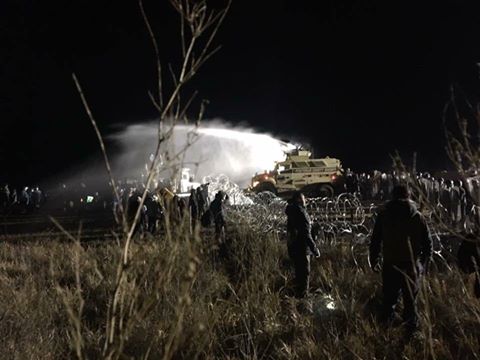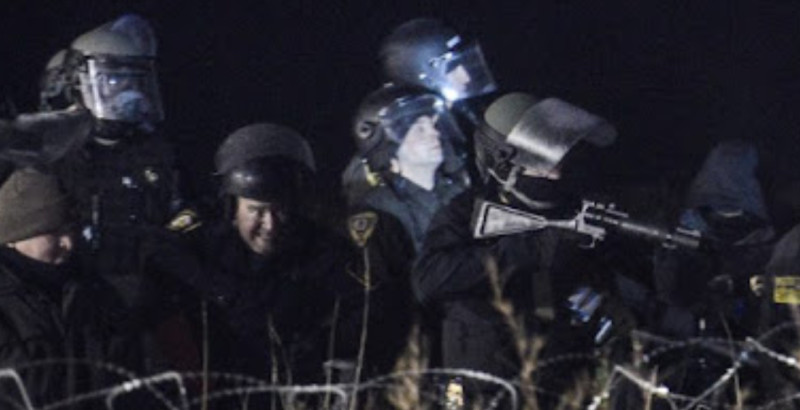From the Open-Publishing Calendar
From the Open-Publishing Newswire
Indybay Feature
Federal Appeals Court Hears Case of Excessive Force by Law Enforcement at Standing Rock
A federal appeals court heard arguments in the class action lawsuit filed for excessive force at Backwater Bridge at Standing Rock, North Dakota, by water protectors who suffered critical injuries. The issues argued include whether the use of munitions, bean bags filled with shot, and water sprayed on water protectors in temperatures below freezing, were justified or legal. Rachel Lederman, lead counsel for water protectors, told the Eighth Circuit Appeals Court's three-member panel of judges, that the district court based its decision in favor of law enforcement on issues that are disputed.

Standing Rock: Federal Appeals Court Hears Case of Law Enforcement Brutality at Backwater Bridge
By Brenda Norrell
Censored News
A federal appeals court heard arguments in the class action lawsuit filed for excessive force at Backwater Bridge at Standing Rock, North Dakota, by water protectors who suffered critical injuries on the night of November 20, 2016. The issues argued include whether the use of munitions, bean bags filled with shot, and water sprayed on water protectors in temperatures below freezing, were justified or legal.
Rachel Lederman, lead counsel for water protectors, told the Eighth Circuit Appeals Court's three-member panel of judges, that the district court based its decision in favor of law enforcement on issues that are disputed.
Lederman, an attorney with the Center for Protest Law and Litigation, said that a jury should decide whether it was objectionably reasonable for officers to bombard hundreds of individuals with high-pressure water hoses, impact munitions, explosives, and chemical agents for ten hours, causing serious injuries, for the people that were allegedly causing problems.
“The story defendants have put forth to justify their use of force is hotly disputed."
Lederman said the plaintiffs suffered serious injuries, including broken bones, and detached retina. Hundreds needed medical attention. There was no evidence that any of the plaintiffs threw anything or were threatening in any way -- but they were hit in parts of the body that constitute deadly force, such as the head, chest, and groin.
Water protectors brought this action against Morton County, North Dakota and their Sheriff's Department; Stutsman County, North Dakota and their Sheriff's Department; and the City of Mandan, North Dakota. They also included 100 unnamed individual law enforcement officers as defendants.
Read more about this case at Censored News
https://bsnorrell.blogspot.com/2023/09/federal-appeals-court-heard-arguments.html
Copyright Censored News. Censored News is a service to Indigenous Peoples upholding human rights, without ads, salaries or revenues. Now in its 18th year, it has more than 23 million page views.
By Brenda Norrell
Censored News
A federal appeals court heard arguments in the class action lawsuit filed for excessive force at Backwater Bridge at Standing Rock, North Dakota, by water protectors who suffered critical injuries on the night of November 20, 2016. The issues argued include whether the use of munitions, bean bags filled with shot, and water sprayed on water protectors in temperatures below freezing, were justified or legal.
Rachel Lederman, lead counsel for water protectors, told the Eighth Circuit Appeals Court's three-member panel of judges, that the district court based its decision in favor of law enforcement on issues that are disputed.
Lederman, an attorney with the Center for Protest Law and Litigation, said that a jury should decide whether it was objectionably reasonable for officers to bombard hundreds of individuals with high-pressure water hoses, impact munitions, explosives, and chemical agents for ten hours, causing serious injuries, for the people that were allegedly causing problems.
“The story defendants have put forth to justify their use of force is hotly disputed."
Lederman said the plaintiffs suffered serious injuries, including broken bones, and detached retina. Hundreds needed medical attention. There was no evidence that any of the plaintiffs threw anything or were threatening in any way -- but they were hit in parts of the body that constitute deadly force, such as the head, chest, and groin.
Water protectors brought this action against Morton County, North Dakota and their Sheriff's Department; Stutsman County, North Dakota and their Sheriff's Department; and the City of Mandan, North Dakota. They also included 100 unnamed individual law enforcement officers as defendants.
Read more about this case at Censored News
https://bsnorrell.blogspot.com/2023/09/federal-appeals-court-heard-arguments.html
Copyright Censored News. Censored News is a service to Indigenous Peoples upholding human rights, without ads, salaries or revenues. Now in its 18th year, it has more than 23 million page views.
For more information:
https://bsnorrell.blogspot.com/2023/09/fed...
Add Your Comments
We are 100% volunteer and depend on your participation to sustain our efforts!
Get Involved
If you'd like to help with maintaining or developing the website, contact us.
Publish
Publish your stories and upcoming events on Indybay.
Topics
More
Search Indybay's Archives
Advanced Search
►
▼
IMC Network




